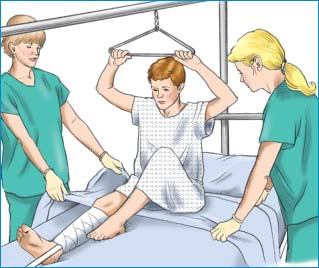Bedmaking, Occupied
For a bedridden patient, linen changes promote comfort and help prevent skin breakdown and health care–acquired infection. Such changes require the use of side rails to prevent the patient from rolling out of bed and, depending on the patient’s condition, the use of a turning sheet to move him from side to side.
Making A Traction Bed
For a patient in traction, obtain help from a coworker to make the bed. Work from head to toe to minimize the risk for traction misalignment.
Preparation
Changing the Linens
Lower both side rails. Stand near the headboard, opposite your coworker.
Gently pull the mattress to the head of the bed. Avoid sudden movements; they can misalign traction and cause patient discomfort.
Remove the pillow from the bed. Loosen the bottom linens and roll them from the headboard toward the patient’s head. Then remove the soiled pillowcase and replace it with a clean one.
Fold a clean bottom sheet crosswise and place the sheet across the head of the bed. Tell the patient to raise her head and upper shoulders by grasping the trapeze above the bed (as shown below). With your coworker, quickly fanfold the bottom sheet from the head of the bed under the patient’s shoulders so that it meets the soiled linen. Tuck at least 12” (30.5 cm) of the bottom sheet under the head of the mattress. Miter the corners and tuck in the sides.
Tell the patient to raise her buttocks by grasping the trapeze. As a team, move toward the foot of the bed and, in one movement, quickly and carefully roll soiled linens and clean linens under the patient.
Instruct the patient to release the trapeze and to rest. Place a pillow under her head for comfort.
If allowed, remove any pillows from under the patient’s extremity. If pillow removal is contraindicated, continue to move linens toward the foot of the bed and under the patient’s legs and traction while your coworker lifts the pillows and supports the patient’s extremity.
Put soiled linens in a laundry bag or pillowcase.
Tuck the remaining loose linens securely under the mattress. To ensure a tight-fitting bottom sheet, have the patient raise herself off the bed by simultaneously grasping the trapeze and raising her buttocks while you pull the sheet tight. As needed, place a drawsheet or linen-saver pad under her. Complete the bed making alone.

If the bottom sheet doesn’t cover the foot of the mattress, cover it with a drawsheet. Miter its corners and tuck in the sides.
Replace the pillows under the patient’s extremity, and then cover her with a clean top sheet. Fold over the top hem of the sheet approximately 8” (20.5 cm). If one or both legs are in traction, fit the lower end of the sheet loosely over the traction apparatus; don’t press on the traction ropes. To secure the sheet, tuck in the corner opposite the traction under the foot of the bed and miter the corner. Neatly tuck in the lower corner of the sheet on the traction side to expose the leg and foot.
If the traction equipment exposes the patient’s sides, cover her with a drawsheet—not a full sheet or spread.
Lower the bed, but don’t allow the traction weights to touch the floor. Raise the side rails to prevent falls. If allowed, leave one side rail down so the patient can reach the bedside stand.
Making an occupied bed may require more than one person. It also entails loosening the bottom sheet on one side and fanfolding it to the center of the mattress instead of loosening the bottom sheet on both sides and removing it, as in an unoccupied bed. Also, the foundation of the bed must be made before the top sheet is applied instead of both the foundation and top being made on one side before being completed on the other side. (See Making a traction bed.)
Stay updated, free articles. Join our Telegram channel

Full access? Get Clinical Tree


